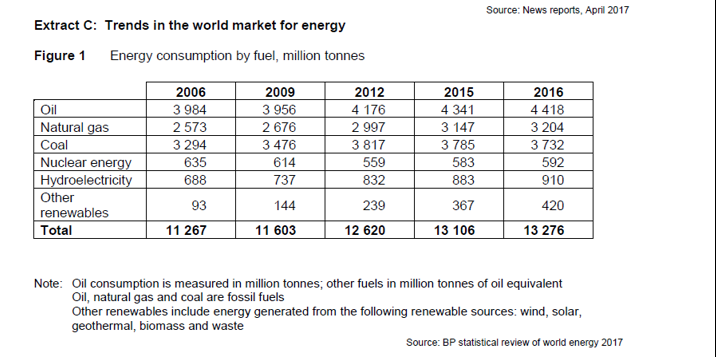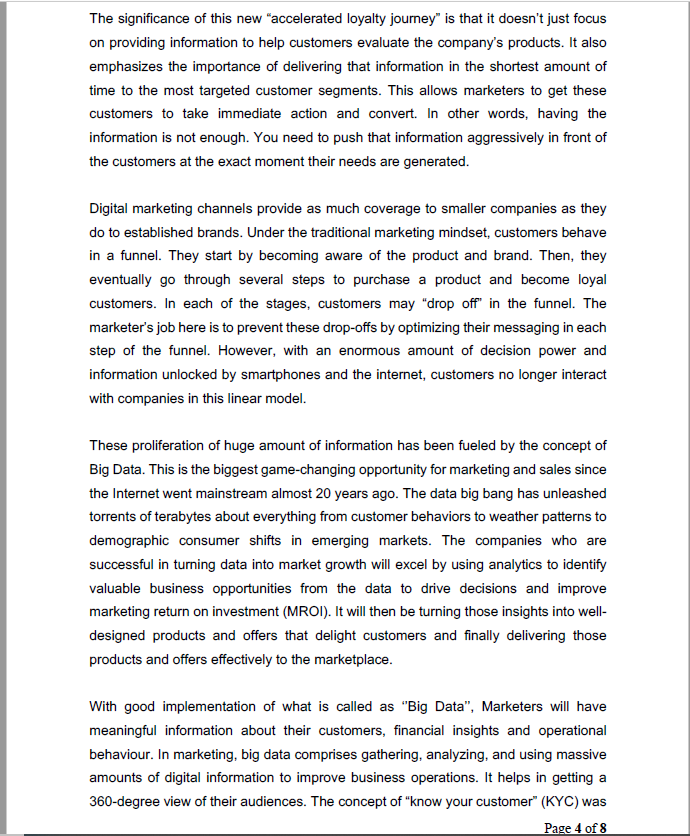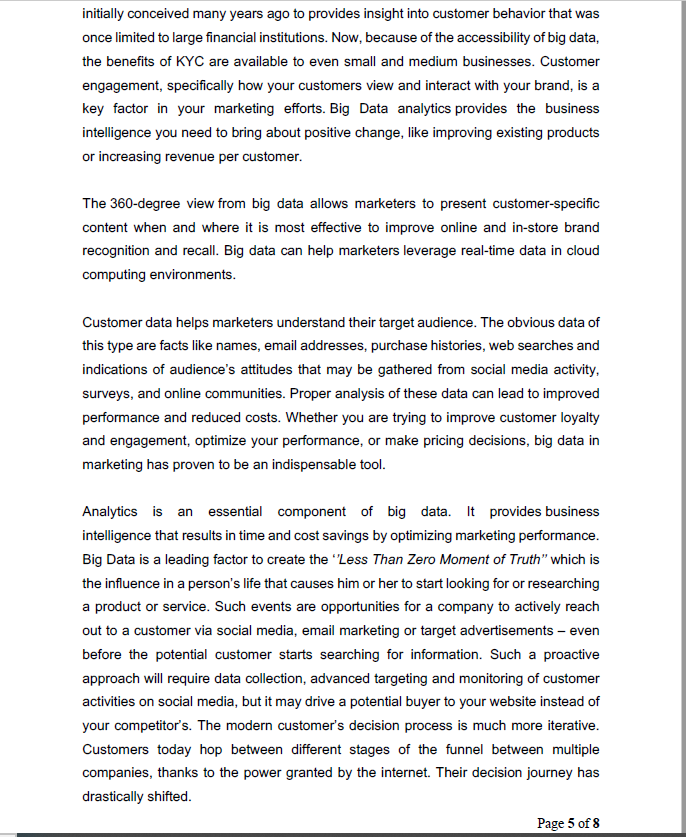





Case Study of fruth The Evolution of Consumer Behavior in the Digital Age 'The Less Than Zero Moment of Truth' Huawow . Adapted from Forbes - June 2019 "We always overestimate the change that will occur in the next two years and underestimate the change that will occur in the next ten." - Bill Gates One of the best examples of how we both overestimate and underestimate changes in the future is the evolution of consumer behavior throughout this century. The digital age has altered how businesses market their products. It has completely shifted the playing field and companies have to review their strategies to reach their customers. Imagine the world we were in 15 years. Back in those days, the way shopping was done for products was drastically different from the way we shop today. Everyone still trusted brick-and-mortar stores with no price comparison services, and consumers were at the mercy of large corporations for discounts. How did we go from that primitive world of shopping to the consumer experience we have today in the digital age? There have been major paradigm shifts in the marketing world in the last 15 years due to the emergence of digital technologies and e- commerce platforms such as Facebook, Amazon, and the adoption of smartphones. More specifically, in just 15 years, shopping went from a linear, retail-focused model, to today's iterative, digital-centric model of customer behavior. Imagine yourself as a customer in the year 2005. You just walked into a grocery store to buy a bottle of shampoo. You look down the aisle and see over 10 shampoos of Page 2 of 8 Source: News reports, April 2017 Extract C: Trends in the world market for energy Figure 1 Energy consumption by fuel, million tonnes Oil Natural gas Coal Nuclear energy Hydroelectricity Other renewables Total 2006 3 984 2573 3 294 635 688 2009 3956 2 676 3 476 614 737 2012 4 176 2 997 3 817 559 832 2015 4 341 3 147 3 785 583 883 2016 4 418 3 204 3732 592 910 420 93 144 239 367 11 267 11 603 12 620 13 106 13 276 Note: Oil consumption is measured in million tonnes; other fuels in million tonnes of oil equivalent Oil, natural gas and coal are fossil fuels Other renewables include energy generated from the following renewable sources: wind, solar, geothermal, biomass and waste Source: BP statistical review of world energy 2017 The significance of this new "accelerated loyalty journey" is that it doesn't just focus on providing information to help customers evaluate the company's products. It also emphasizes the importance of delivering that information in the shortest amount of time to the most targeted customer segments. This allows marketers to get these customers to take immediate action and convert. In other words, having the information is not enough. You need to push that information aggressively in front of the customers at the exact moment their needs are generated. Digital marketing channels provide as much coverage to smaller companies as they do to established brands. Under the traditional marketing mindset, customers behave in a funnel. They start by becoming aware of the product and brand. Then, they eventually go through several steps to purchase a product and become loyal customers. In each of the stages, customers may "drop off" in the funnel. The marketer's job here is to prevent these drop-offs by optimizing their messaging in each step of the funnel. However, with an enormous amount of decision power and information unlocked by smartphones and the internet, customers no longer interact with companies in this linear model. These proliferation of huge amount of information has been fueled by the concept of Big Data. This is the biggest game-changing opportunity for marketing and sales since the Internet went mainstream almost 20 years ago. The data big bang has unleashed torrents of terabytes about everything from customer behaviors to weather patterns to demographic consumer shifts in emerging markets. The companies who are successful in turning data into market growth will excel by using analytics to identify valuable business opportunities from the data to drive decisions and improve marketing return on investment (MROI). It will then be turning those insights into well- designed products and offers that delight customers and finally delivering those products and offers effectively to the marketplace. With good implementation of what is called as "Big Data", Marketers will have meaningful information about their customers, financial insights and operational behaviour. In marketing, big data comprises gathering, analyzing, and using massive amounts of digital information to improve business operations. It helps in getting a 360-degree view of their audiences. The concept of "know your customer" (KYC) was Page 4 of 8 initially conceived many years ago to provides insight into customer behavior that was once limited to large financial institutions. Now, because of the accessibility of big data, the benefits of KYC are available to even small and medium businesses. Customer engagement, specifically how your customers view and interact with your brand, is a key factor in your marketing efforts. Big Data analytics provides the business intelligence you need to bring about positive change, like improving existing products or increasing revenue per customer. The 360-degree view from big data allows marketers to present customer-specific content when and where it is most effective to improve online and in-store brand recognition and recall. Big data can help marketers leverage real-time data in cloud computing environments. Customer data helps marketers understand their target audience. The obvious data of this type are facts like names, email addresses, purchase histories, web searches and indications of audience's attitudes that may be gathered from social media activity, surveys, and online communities. Proper analysis of these data can lead to improved performance and reduced costs. Whether you are trying to improve customer loyalty and engagement, optimize your performance, or make pricing decisions, big data in marketing has proven to be an indispensable tool. Analytics is an essential component of big data. It provides business intelligence that results in time and cost savings by optimizing marketing performance. Big Data is a leading factor to create the "Less Than Zero Moment of Truth which is the influence in a person's life that causes him or her to start looking for or researching a product or service. Such events are opportunities for a company to actively reach out to a customer via social media, email marketing or target advertisements - even before the potential customer starts searching for information. Such a proactive approach will require data collection, advanced targeting and monitoring of customer activities on social media, but it may drive a potential buyer to your website instead of your competitor's. The modern customer's decision process is much more iterative. Customers today hop between different stages of the funnel between multiple companies, thanks to the power granted by the internet. Their decision journey has drastically shifted. Page 5 of 8 Enabled by advanced technologies such as machine learning and artificial intelligence, more and more companies have started to conduct this type of "hyper-speed targeting" to their audience. This marks a new age of marketing automation and acceleration. While these shifts in marketing may seem very different, the underlying theme is the same: customers are becoming more powerful in making their own purchasing decisions. As the information available to customers proliferate, this trend will only accelerate in the next decade, making "customer-centric" marketing even more important for companies to succeed with some major shifts in the marketing approaches in the digital age. The digital age has changed everything about the way companies market themselves. It has revolutionized the reach of small businesses, while demanding more from already established businesses. While many people have complained about this new world, it has spelled opportunity for many others. 1485 words SECTION A - Case Study Questions QUESTION 1 (a) Describe the 5-Stage Consumer Behaviour Model. [10 marks] (b) Using examples from the case study critically analyse how Digital Technologies are disrupting this consumer behavior model? [15 marks] Case Study of fruth The Evolution of Consumer Behavior in the Digital Age 'The Less Than Zero Moment of Truth' Huawow . Adapted from Forbes - June 2019 "We always overestimate the change that will occur in the next two years and underestimate the change that will occur in the next ten." - Bill Gates One of the best examples of how we both overestimate and underestimate changes in the future is the evolution of consumer behavior throughout this century. The digital age has altered how businesses market their products. It has completely shifted the playing field and companies have to review their strategies to reach their customers. Imagine the world we were in 15 years. Back in those days, the way shopping was done for products was drastically different from the way we shop today. Everyone still trusted brick-and-mortar stores with no price comparison services, and consumers were at the mercy of large corporations for discounts. How did we go from that primitive world of shopping to the consumer experience we have today in the digital age? There have been major paradigm shifts in the marketing world in the last 15 years due to the emergence of digital technologies and e- commerce platforms such as Facebook, Amazon, and the adoption of smartphones. More specifically, in just 15 years, shopping went from a linear, retail-focused model, to today's iterative, digital-centric model of customer behavior. Imagine yourself as a customer in the year 2005. You just walked into a grocery store to buy a bottle of shampoo. You look down the aisle and see over 10 shampoos of Page 2 of 8 Source: News reports, April 2017 Extract C: Trends in the world market for energy Figure 1 Energy consumption by fuel, million tonnes Oil Natural gas Coal Nuclear energy Hydroelectricity Other renewables Total 2006 3 984 2573 3 294 635 688 2009 3956 2 676 3 476 614 737 2012 4 176 2 997 3 817 559 832 2015 4 341 3 147 3 785 583 883 2016 4 418 3 204 3732 592 910 420 93 144 239 367 11 267 11 603 12 620 13 106 13 276 Note: Oil consumption is measured in million tonnes; other fuels in million tonnes of oil equivalent Oil, natural gas and coal are fossil fuels Other renewables include energy generated from the following renewable sources: wind, solar, geothermal, biomass and waste Source: BP statistical review of world energy 2017 The significance of this new "accelerated loyalty journey" is that it doesn't just focus on providing information to help customers evaluate the company's products. It also emphasizes the importance of delivering that information in the shortest amount of time to the most targeted customer segments. This allows marketers to get these customers to take immediate action and convert. In other words, having the information is not enough. You need to push that information aggressively in front of the customers at the exact moment their needs are generated. Digital marketing channels provide as much coverage to smaller companies as they do to established brands. Under the traditional marketing mindset, customers behave in a funnel. They start by becoming aware of the product and brand. Then, they eventually go through several steps to purchase a product and become loyal customers. In each of the stages, customers may "drop off" in the funnel. The marketer's job here is to prevent these drop-offs by optimizing their messaging in each step of the funnel. However, with an enormous amount of decision power and information unlocked by smartphones and the internet, customers no longer interact with companies in this linear model. These proliferation of huge amount of information has been fueled by the concept of Big Data. This is the biggest game-changing opportunity for marketing and sales since the Internet went mainstream almost 20 years ago. The data big bang has unleashed torrents of terabytes about everything from customer behaviors to weather patterns to demographic consumer shifts in emerging markets. The companies who are successful in turning data into market growth will excel by using analytics to identify valuable business opportunities from the data to drive decisions and improve marketing return on investment (MROI). It will then be turning those insights into well- designed products and offers that delight customers and finally delivering those products and offers effectively to the marketplace. With good implementation of what is called as "Big Data", Marketers will have meaningful information about their customers, financial insights and operational behaviour. In marketing, big data comprises gathering, analyzing, and using massive amounts of digital information to improve business operations. It helps in getting a 360-degree view of their audiences. The concept of "know your customer" (KYC) was Page 4 of 8 initially conceived many years ago to provides insight into customer behavior that was once limited to large financial institutions. Now, because of the accessibility of big data, the benefits of KYC are available to even small and medium businesses. Customer engagement, specifically how your customers view and interact with your brand, is a key factor in your marketing efforts. Big Data analytics provides the business intelligence you need to bring about positive change, like improving existing products or increasing revenue per customer. The 360-degree view from big data allows marketers to present customer-specific content when and where it is most effective to improve online and in-store brand recognition and recall. Big data can help marketers leverage real-time data in cloud computing environments. Customer data helps marketers understand their target audience. The obvious data of this type are facts like names, email addresses, purchase histories, web searches and indications of audience's attitudes that may be gathered from social media activity, surveys, and online communities. Proper analysis of these data can lead to improved performance and reduced costs. Whether you are trying to improve customer loyalty and engagement, optimize your performance, or make pricing decisions, big data in marketing has proven to be an indispensable tool. Analytics is an essential component of big data. It provides business intelligence that results in time and cost savings by optimizing marketing performance. Big Data is a leading factor to create the "Less Than Zero Moment of Truth which is the influence in a person's life that causes him or her to start looking for or researching a product or service. Such events are opportunities for a company to actively reach out to a customer via social media, email marketing or target advertisements - even before the potential customer starts searching for information. Such a proactive approach will require data collection, advanced targeting and monitoring of customer activities on social media, but it may drive a potential buyer to your website instead of your competitor's. The modern customer's decision process is much more iterative. Customers today hop between different stages of the funnel between multiple companies, thanks to the power granted by the internet. Their decision journey has drastically shifted. Page 5 of 8 Enabled by advanced technologies such as machine learning and artificial intelligence, more and more companies have started to conduct this type of "hyper-speed targeting" to their audience. This marks a new age of marketing automation and acceleration. While these shifts in marketing may seem very different, the underlying theme is the same: customers are becoming more powerful in making their own purchasing decisions. As the information available to customers proliferate, this trend will only accelerate in the next decade, making "customer-centric" marketing even more important for companies to succeed with some major shifts in the marketing approaches in the digital age. The digital age has changed everything about the way companies market themselves. It has revolutionized the reach of small businesses, while demanding more from already established businesses. While many people have complained about this new world, it has spelled opportunity for many others. 1485 words SECTION A - Case Study Questions QUESTION 1 (a) Describe the 5-Stage Consumer Behaviour Model. [10 marks] (b) Using examples from the case study critically analyse how Digital Technologies are disrupting this consumer behavior model? [15 marks]












